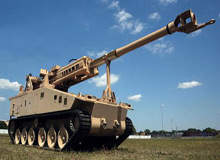
Over the summer, in a press release, the US Army’s Tank-Automotive Research, Development, and Engineering Center (TARDEC) announced that its new diesel-electric hybrid propulsion system was moving into the ‘hot buck’ testing stage, a realistic simulation environment that is the last stop before full-on field testing.
Having performed well in this stage to date, the Army could introduce the hybrid engine as early as next year. The system would debut with the non-line-of-sight cannon, a 155mm self-propelled howitzer, and would ultimately power the Army’s entire fleet of manned ground vehicles.

Discover B2B Marketing That Performs
Combine business intelligence and editorial excellence to reach engaged professionals across 36 leading media platforms.
One may regard the Army’s embrace of eco-friendly propulsion technology as the height of irony, but the rationale for applying hybrid technology to combat vehicles has nothing to do with environmental consciousness. In fact, hybrid engines already offer compelling operational benefits that will become even more important in the future. These benefits can be summarised in four words: better mileage, lower visibility.
BETTER MILEAGE: LESS IS MORE
Since World War II, fuel supplies have been the primary limiting factor for army strategic mobility. Indeed, the main reason American and British armoured divisions couldn’t finish off the Wehrmacht on the Western Front in 1944 was that they outran their fuel supplies. This is not surprising when you consider that the Sherman tank averaged 0.5mpg.
Unfortunately for logistics planners, net fuel efficiency hasn’t improved much over the past 60 years. More precisely, fuel economy has improved by 20%, based on an average of 0.6mpg for the M1A2 Abrams tank. Even so, this is not much worse than the relatively flyweight Humvee, which averages about 4mpg.

US Tariffs are shifting - will you react or anticipate?
Don’t let policy changes catch you off guard. Stay proactive with real-time data and expert analysis.
By GlobalDataGranted, the Abrams can do things the Sherman couldn’t even dream about, such as reach top speeds of over 60mph with its aircraft-grade turbine engine. With the all-in cost of combat-zone gasoline in Iraq at $400/gal, however, army generals face the same dilemma as Maserati owners: when does performance become too costly?
HYBRID TECHNOLOGY
Enter the diesel-electric hybrid engine, which turns traditional engineering tradeoffs into win-win situations. Traditional gas engines are sized for the peak power requirement (e.g. passing another vehicle on a two-way road) but most drivers, whether on local roads or in a free-fire zone, use peak power less than 1% of the time. The hybrid car uses a much smaller combustion engine that is roughly optimised for the average power requirement, and therefore is much more efficient for a variety of reasons.
Then why is the kerb weight of the hybrid SUV greater than that of its traditional twin? Because of the battery component which puts the electric-hybrid component into the engine. The second key inefficiency of a traditionally powered car is that it inherently produces more energy than it needs to accomplish the work it needs to do at any given time. In the past this energy was wasted, but now the battery component can corral this energy and store it for later use.
Using civilian SUVs as an empirically tested baseline, the benefits are unequivocal. SUV hybrids offer almost a one-third increase in combined fuel efficiency over their traditional gas-engine brothers.
Although sceptics rightly note that most of this gain accrues from city driving, where hybrids offer a 50% efficiency gain, tactical mobility in actual battle involves ‘shoot and scoot’ manoeuvring quite similar to the stop-and-go rhythm of city driving.
THE BIGGER PICTURE
In the larger operational context, moreover, fuel efficiency creates a synergistic ripple effect from the ‘tip of the spear’ back through the logistics chain. For example, more distance per tank of fuel means fewer fuel trucks, fewer refuelling breaks, or some combination of both.
Fewer fuel trucks mean not only more resources released for other uses but also less fuel consumed by the fuel truck fleet. And if the trucks themselves are hybrids, then the fuel savings compound, like interest on interest. On the other hand, fewer refueling breaks mean a higher operational tempo, not to mention less exposure of the vulnerable supply chain to hostile fire. No matter how you slice it you end up with gains somewhere.
Finally, fuel efficiency is important for strategic sustainability. The US military consumes about 1.7 million gallons of gas a day in Iraq. Even assuming that 40% of this goes toward naval and air force needs, a million gallons a day in daily consumption would imply a ballpark 200,000gal/day savings with only a 25% increase in fuel efficiency. At even $50/gal all-in, hybrid engines could save the US Army over $3bn a year in Iraq alone.





